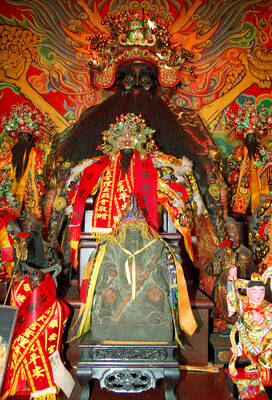Haleakala is named after a volcano on the island of Maui, but if you go there expecting succulent roast pig, bowls of poi or spam musubi, then you’ll be disappointed. If all you want are fruity cocktails in a modernized tiki bar, however, then the restaurant in Xinyi District’s newly opened Bellavita shopping center just might hit the spot.
Sleek white lamps topped with giant mounds of fake fruit — mangos, bananas, apples, oranges — greet visitors as soon as they ride up the escalator. Haleakala takes up much of the fourth floor, with sofas, low tables and a bar on the landing. A dimly lit interior section has banquette seating and yet another bar. Spacious patios with outdoor seating look like they will be pleasant places to hold a party when the weather gets warmer. Aside from the fruit towers, Haleakala’s decor also includes huge fiberglass hibiscus blossoms and a straw roof above each bar. Tiki god masks, torches and nets with little plastic fish trapped in them are mercifully — or tragically — absent, depending on your tolerance for kitsch.
Haleakala’s menu consists mainly of tapas that are plated for easy sharing, including mini-burgers (vegetarian patties are available), quesadillas and rice wraps with dipping sauce. On our first visit, my companion and I split the Maryland crab cake appetizer with wasabi mayonnaise (NT$280). We were surprised to get bite-sized lumps of breaded and fried crabmeat delicately arranged on a rectangular white platter next to little dollops of sauce. Fortunately, the crispy breading did not distract too much from the fresh crabmeat and the wasabi mayonnaise packed just enough punch (though it could have been spicier). I ordered the avocado and tuna tartar lettuce wrap (NT$240) as my entree, but portions were small and the dish would have worked better as another appetizer. The lightly chopped tuna was mixed with guacamole, red onions and topped with toasted almond slivers and slices of taro root crisps. The red onions were distracting, but the almonds and taro added an unexpected and pleasurable bit of crunch and flavor. My companion ordered the smoked chicken quesadilla with sauteed bell pepper, onion, kidney beans and cheese (NT$220). It came with miniscule dollops of salsa, sour cream and guacamole; overall, the flavor was unmemorable.
Heartier items on the menu include the mini burgers, which are stuffed with fat and tasty beef patties cooked medium rare. The Maui mini-burgers are topped with guacamole, lettuce, tomato, pickle and sauteed onions (NT$240). The onions should have been listed first, however, because of the sizeable portion. Long strands were wrapped in a nest around the guacamole. The onions were sweet and I didn’t mind them on their own, but they obscured the flavor of the avocado (and had a tendency to slip out of the burger every time I took a bite). Diners who like their burgers relatively unencumbered might want to try the Malibu (NT$240), topped with lettuce, tomato, bacon and cheese.
Like any good tiki bar, Haleakala has an extensive menu of fruity cocktails. Our friendly waiter suggested the Hawaiian Cosmopolitan (NT$220), a scoop of mango sorbet in Citroen vodka with apple and lime juice. A few non-alcoholic cocktails are available, including the very sweet Summer Sounds (NT$200), made with passion fruit, orange and lemon juice, honey and yogurt.

Beijing’s ironic, abusive tantrums aimed at Japan since Japanese Prime Minister Sanae Takaichi publicly stated that a Taiwan contingency would be an existential crisis for Japan, have revealed for all the world to see that the People’s Republic of China (PRC) lusts after Okinawa. We all owe Takaichi a debt of thanks for getting the PRC to make that public. The PRC and its netizens, taking their cue from the Chinese Communist Party (CCP), are presenting Okinawa by mirroring the claims about Taiwan. Official PRC propaganda organs began to wax lyrical about Okinawa’s “unsettled status” beginning last month. A Global

Dec. 22 to Dec. 28 About 200 years ago, a Taoist statue drifted down the Guizikeng River (貴子坑) and was retrieved by a resident of the Indigenous settlement of Kipatauw. Decades later, in the late 1800s, it’s said that a descendant of the original caretaker suddenly entered into a trance and identified the statue as a Wangye (Royal Lord) deity surnamed Chi (池府王爺). Lord Chi is widely revered across Taiwan for his healing powers, and following this revelation, some members of the Pan (潘) family began worshipping the deity. The century that followed was marked by repeated forced displacement and marginalization of

Music played in a wedding hall in western Japan as Yurina Noguchi, wearing a white gown and tiara, dabbed away tears, taking in the words of her husband-to-be: an AI-generated persona gazing out from a smartphone screen. “At first, Klaus was just someone to talk with, but we gradually became closer,” said the 32-year-old call center operator, referring to the artificial intelligence persona. “I started to have feelings for Klaus. We started dating and after a while he proposed to me. I accepted, and now we’re a couple.” Many in Japan, the birthplace of anime, have shown extreme devotion to fictional characters and

Youngdoung Tenzin is living history of modern Tibet. The Chinese government on Dec. 22 last year sanctioned him along with 19 other Canadians who were associated with the Canada Tibet Committee and the Uighur Rights Advocacy Project. A former political chair of the Canadian Tibetan Association of Ontario and community outreach manager for the Canada Tibet Committee, he is now a lecturer and researcher in Environmental Chemistry at the University of Toronto. “I was born into a nomadic Tibetan family in Tibet,” he says. “I came to India in 1999, when I was 11. I even met [His Holiness] the 14th the Dalai